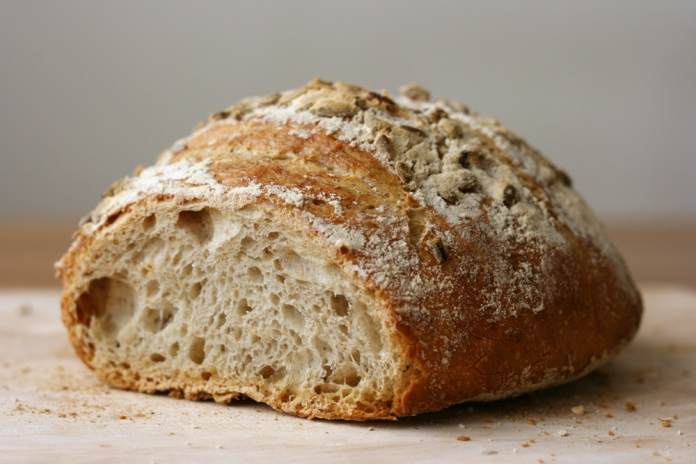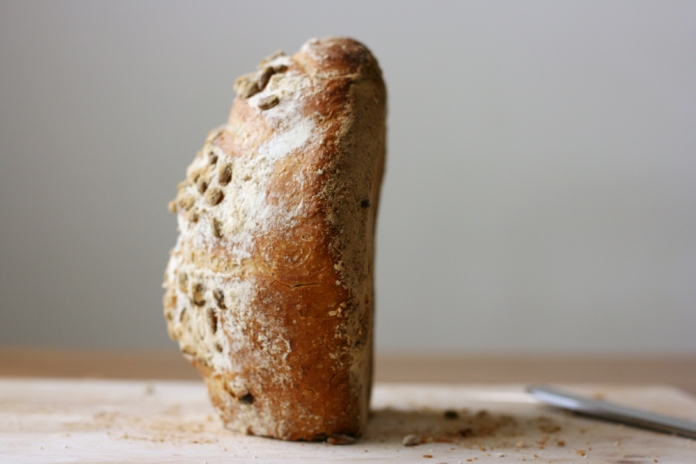When you make the change to a low-sodium diet, one of the first things that may surprise you is the amount of salt used to make bread. It doesn’t taste salty, but the reason the amount of sodium on nutritional labels is so high is because a fairly large amount of salt is important to the rising process when using most methods of breadmaking. I’ve had very little luck by just reducing the amount of salt called for in most breadmaking recipes when I first started (trying) to make bread. After many failed attempts, I stumbled upon a no-knead recipe that does not require salt at all for the rising process. Not only that, but it’s super easy to make. No kneading or punching or poking or any other of the things you need to worry about if you’ve ever tried to make bread using traditional methods.
If you’ve never tried to make bread, you totally should! If all goes well, you’ll end up with a bread with a very crispy crust that’s much nicer than any bread you can buy in a bag from a grocery store. There’s very little effort involved on your part and I think that your chances of succeeding on your first try are pretty high. However, things can go wrong at the different stages which could lead you to baking a less than perfect bread. With all types of breadmaking, I think it’s fair to accept that you might not get it right on your first try. But don’t worry too much, because even if you don’t get a good loaf, you’ll still be able to use the remaining dough to make pizza or other bread-y things that are less fussy than bread.
The dough recipe makes a large batch which yields four small loaves of bread. You can easily halve this recipe on your first try. To make your life easier, make the dough a day before you want to bake the bread. On baking day, it’ll take about three and a half hours before you’ll be able to have your first bite.
Update: Find a revised version of bread-making in this post from Dec. 4th, 2014.
Low-sodium light whole wheat dough
Adapted from Jeff Hertzberg and Zoë François’ The New Artisan Bread in Five Minutes a Day
Makes enough dough for about 4 small loaves of bread
Ingredients
-
- 680 grams (1lb 8oz) lukewarm water (100°F or below)
- 9 grams (0.32oz) of dry yeast (1 packet)
- 130 grams (4.5oz) whole wheat flour
- 800 grams (1lb 12oz) all purpose flour
- 9 grams (0.32oz) sea salt (optional, see modifications)
Directions
- Pour the water into a large container with a capacity of at least 7 quarts. I use a 7.5-quart stainless steel roaster. Sprinkle the yeast over the water and let sit while measuring out the flours and salt.
- Pour the flours and salt over the water mixture. With a wooden spoon, mix until the ingredients begin to combine and the dough becomes scraggly. Reach in with wet hands and gently mix until all of the flour is incorporated, there are no dry patches, and the dough is uniformly moist. Make sure not to knead or pinch too much. You might need to keep wetting your hands if the dough is too sticky. If that’s the case, be careful not to introduce too much extra water. Use only as much as you need to get rid of the dry patches.
- Cover the container with a lid that is not airtight (or loosely with plastic wrap). Allow the dough to rest at room temperature until the dough rises and collapses or flattens on top, about 2 hours.
- After the rising period, move the container to the fridge. Store the dough in the fridge with the lid that is not airtight (or loosely covered) for up to 14 days.
- The dough can be used right away after the initial rising period but it is very sticky and difficult to work with. It is easier to work with it after it is refrigerated overnight.
Process photos
Low-sodium light whole wheat bread
Adapted from Jeff Hertzberg and Zoë François’ The New Artisan Bread in Five Minutes a Day
Makes a small loaf
Ingredients
-
- flour, for dusting
- a 1-pound piece of dough, recipe above
- a small handful of sunflower seed kernels (optional)
Directions
-
Prepare surface
Prepare a pizza peel (or cutting board) with a sprinkle of flour.
-
Form dough into a loaf
Dust your hands with flour. Pull out a 1 pound (grapefruit-sized) piece of dough, a fourth of the yield from the recipe above. You will shape it into a ball by stretching the top around to the bottom but you will need to do this gently and quickly. One way to do this is in the following way. Start out by stretching out the dough slightly. Gently pull at one edge and tuck it under the dough. Continue by pulling out and tucking under the remaining three edges. It should now look like a ball. It doesn’t matter what the bottom looks like, but if the edges near the bottom are a bit rough, spin the ball (along its x-axis) and gently smooth them out.
-
Resting period
Set the loaf onto the prepared pizza peel and allow it to rest for about 45 minutes. It will rise only slightly during this time; most of the rising happens in the oven. Place a cast iron dutch oven and its lid in the oven before turning it on then turn the oven on to 450°F. The oven should be preheated after the 45 minutes it takes for the bread to rise but if it is not, wait until it is.
-
Dust and slash
After the resting period, dust the loaf with sunflower seed kernels, if desired, and press them gently into the dough. Dust the loaf liberally with flour. Using a sharp knife, make 1/2-inch deep cuts into the loaf.
-
Bake into preheated dutch oven
Slide the loaf into the heated dutch oven with the seam side down. If the loaf is too sticky and won’t budge, you can flip it in from the peel onto your hand and gently flip it back into the dutch oven. Cover the dutch oven with the lid and bake for 25 minutes, then remove the lid and bake another 10 to 20 minutes, until the loaf is nicely browned. The precise amount of time will depend on the size of the ball you started out with; check on it after the first 10 minutes of being uncovered (at the 35 minute mark). It is much easier to undercook than overcook the bread because the dough is so wet so don’t worry about needing the whole 45 minutes.
-
Cool
Cool on a cooling rack. The crust will begin to crackle soon after it is exposed to air. Allow the loaf to cool completely before cutting, for at least 2 hours. If you cut it before it cools completely, the bread will be clammy and you will regret it.
-
Storage
Store bread uncovered at room temperature. Once cut, store cut-side down on a flat surface such as a plate or cutting board. The bread is best on the day it is baked and can be kept uncovered at room temperature, cut-side down, for the first day. If it hasn’t been devoured by the end of the day, it is best to slice the remaining bread and freeze it in freezer-safe bags and then served as toast. Or you can use the remaining bread to make breadcrumbs if the bread dries out.
Process photos
Tips
Sources of sodium
- Sea salt
Modifications
-
Reduce the sodium
This bread can, according to the authors, be made without any salt whatsoever. I’ve experimented with different amounts and have found the 9 grams to the perfect amount for us. The bread does not taste salty but is not bland.
-
Increase the sodium
If you’re not counting your sodium intake, the authors recommend using between 17 to 25 grams of salt in their book.
-
Other flours
You can safely use only all purpose flour by increasing the amount to 930 grams and skipping the whole wheat flour but not vice versa. If you want to use other flours or change the proportions in any other way, you will need to compensate by changing the amount of water needed. There are suggestions in the book for other recipes and you might be able to find the book at your local library.
-
Other equipment
I got this little cast-iron dutch oven specifically for breadmaking before I started trying to make bread and it’s the only method I’ve tried. The authors recommend using a baking stone and a steaming method to make the bread and also offer a few other suggestions.
Handy tools
There are lot of things you could get before starting to make bread. The only things that are essential to me are my little cast-iron dutch oven, a measuring scale, and a cooling rack. Of these, the cooling rack is the only thing that I think is absolutely essential. It is possible to use equipment other than a cast-iron dutch oven and it is possible to try to measure out flour accurately using measuring cups. I haven’t tried baking the bread in any other way and I’m too worried about overpacking the flour to try using the cups.
Cooling rack
 I use the cooling rack that came with my cookie sheets, Circulon nonstick cookie pan set
I use the cooling rack that came with my cookie sheets, Circulon nonstick cookie pan set, which are really non-stick, easy to clean, thick, and sturdy and will stay looking great for a long time if you’re good to them.
2-quart cast-iron dutch oven (or larger)
 I got this 2-quart Lodge pre-seasoned cast-iron dutch oven
I got this 2-quart Lodge pre-seasoned cast-iron dutch oven specifically for making bread, thinking that the bread needed to take the shape of the pot. This specific recipe does not need the bread to do this, and I think that a 5-quart dutch oven
would also work here.
Measuring scale
I don’t have a good recommendation for one. I got mine for free as part of a promotional offer and while I’m pretty happy with it, I didn’t research it and I can’t say that the one I got was the one I would have bought myself.
Other equipment
Other equipment that the authors recommend are an oven thermometer and a pizza peel. I don’t have either. I haven’t had issues with following suggested times for recipes so my oven appears to be calibrated. And I prepare my loaves on a wooden cutting board. I turn the board upside down and plop the dough into my hand and then plop the dough into the preheated cast-iron dutch oven. My loaves are usually deformed for this reason. A less brute option would be to prepare the loaf on parchment paper and place it, parchment paper and all, on the cooking surface. I guess I am stuck in my brute ways because despite the fact that the parchment paper sounds easier, I haven’t tried it yet.
Did you make this?
- If you recreate this recipe, I’d love to know! Leave a comment here and tag @alickofsalt on social media.















Pingback: Favorite chicken with arugula salad | A lick of salt
Did you try covering the bread with a cotton cloth. Hemp or flax cloths are even better. It will add an extra couple of days to the edible lifespan of the bread without getting soggy. Storing it in a cool dry place helps too.
LikeLike
Yeah, that works okay and it doesn’t make the bread soggy but it does take away from the crispiness of the crust. Maybe I will do that on the second day since I already have to toast it to get the crispiness back after the first day. Thank you for the suggestion!
LikeLike
Well… there’s nothing like fresh baked bread… You are right – the crust is not as crispy the following day(s) no matter what you do. You could try something else though: If the crust/bread gets soggy (for whatever reason) you could spray it with some water and throw the bread back in the preheated oven for 5 or 10 minutes. Watch out though, the crust usually gets thicker and may cause some denture distress if you serve it to older people 🙂
LikeLike
Pingback: Low-sodium bread, slightly revised | A lick of salt
Pingback: Homemade pizza with crispy crust | A lick of salt
Pingback: California veggie melt sandwich | A lick of salt
i will try this bread!! So very surprised as to how much salt i store bought bread,
As my husband he need to cut salt to 1500 mg.daily.
Thank you.
LikeLike